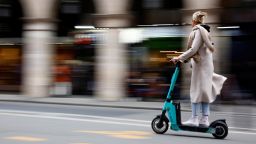Editor’s Note: Jill Filipovic is a journalist based in New York and author of the book “OK Boomer, Let’s Talk: How My Generation Got Left Behind.” Follow her on Twitter. The opinions expressed in this commentary are solely her own. View more opinion on CNN.
The people of Paris have spoken loud and clear: get electric scooters off of our streets.
Good. More cities should follow suit.

Over the past few years, electric scooters have been brought to Paris and dozens of other cities worldwide by various startups promising an environmentally-friendly individual transport option. What cities have gotten instead is chaos: scooters shooting down sidewalks at dangerous speeds or laying abandoned on pedestrian thoroughfares. Both riders and pedestrians have been injured and sometimes killed.
Scooters sound great in theory. In practice, they’re much more of a menace than a convenience.
The Paris vote was an overwhelming one, if one with very low turnout — only about 100,000 people voted, but nearly 90% of them cast their ballots in favor of a scooter ban, according to CNBC. It’s easy to see why.
When it comes to scooters, there are often not many rules regulating them, and enforcement is spotty. In Paris, for example, children as young as 12 could rent them and helmets were not required. While the city technically banned multiple riders on a single scooter and scooters on sidewalks, it is not unusual in Paris to see snuggling couples on a single scooter, flying down a city sidewalk.
In New York City, there is a scooter speed limit and scooters are supposed to only be in bike lanes and streets. But again, enforcement is lax, helmets are not required for adults and it’s pretty rare to see a New York City cop doling out a ticket to a scooter rider.
Other cites require scooter riders to abide by standard traffic laws, but a walk through many scooter-heavy metropolises makes clear that these regulations are often skirted.
One problem with scooters is that there is no obvious spot for them within urban infrastructure. They go far too fast to be safe on the sidewalk, and in American cities, sidewalks are often already too narrow to accommodate pedestrians, parents with strollers and people who use wheelchairs and other assistive devices. Walking down the sidewalk shouldn’t require dodging electric devices going far faster than a person can move on foot — or risking an accident. And people pushing strollers, on crutches or using wheelchairs shouldn’t have their ability to use the sidewalk curtailed by the scooters that riders routinely leave strewn on the sidewalk.
But scooters are also inappropriate for the bike lane — they don’t move like bikes, which, at least anecdotally, makes them difficult to see and navigate around and can be dangerous for scooter drivers, cyclists and people driving cars. Because they’re a relatively novel form of transportation, drivers may not be looking for them the way drivers are used to looking for bikes. I can’t imagine many cyclists love their already-congested and often-dangerous bike lanes clogged up by scooters. And without mandatory helmet laws for adults riding electric scooters, riders are in even more danger.
Scooters also aren’t suitable for the road. In many cities they aren’t supposed to go very fast, and yet they are permitted on some roadways, competing with cars. In New York City, for example, scooters aren’t supposed to be on roads with speed limits above 30 miles per hour (mph), but scooters themselves aren’t allowed to go more than 15 mph, creating a real conflict. Scooters don’t go fast enough to share space with cars; they go too fast to be safe for unprotected riders; and their riders are not protected against hulking vehicles going 30 miles per hour or more. If it’s car vs. scooter, the car is going to win.
Nighttime is also a dangerous time to be on a scooter; some cities, including Atlanta, have banned scooter riding at night, or seriously considered doing so, because of unnecessary deaths and injuries.
Counter to the idea that this is making cities greener, there’s also little evidence that a significant number of scooter riders would be driving cars or taking taxis if they weren’t on a scooter. Many cities with electric scooters for rent also offer subways and city bikes, two better options for both users and the general public.
I’ve lived in cities overtaken by scooters, most notably Washington, DC. In 2019, my morning walk to my workplace there was often a theater of scooter-dodging, as reckless riders breezed past and I stepped over the many scooters that were simply dumped wherever a rider decided to disembark. Over the course of a year, I saw several injured riders in the road — all luckily seemed ok, but banged up after a collision with a car, bicycle or pedestrian. And I continuously wondered: Why does anyone think this is a good idea?
Parisians have come to their senses and said that it’s not. In American cities where public transport is solid and pedestrians fill the sidewalks, scooters should also see themselves out or be regulated out. And in the many American cities where cars dominate and public transport is lacking, the priority should be building new infrastructure to move people around efficiently and greenly, not allowing tech startups to run roughshod over public space.





